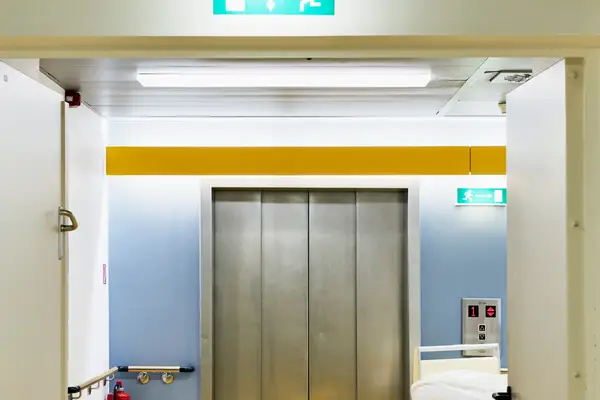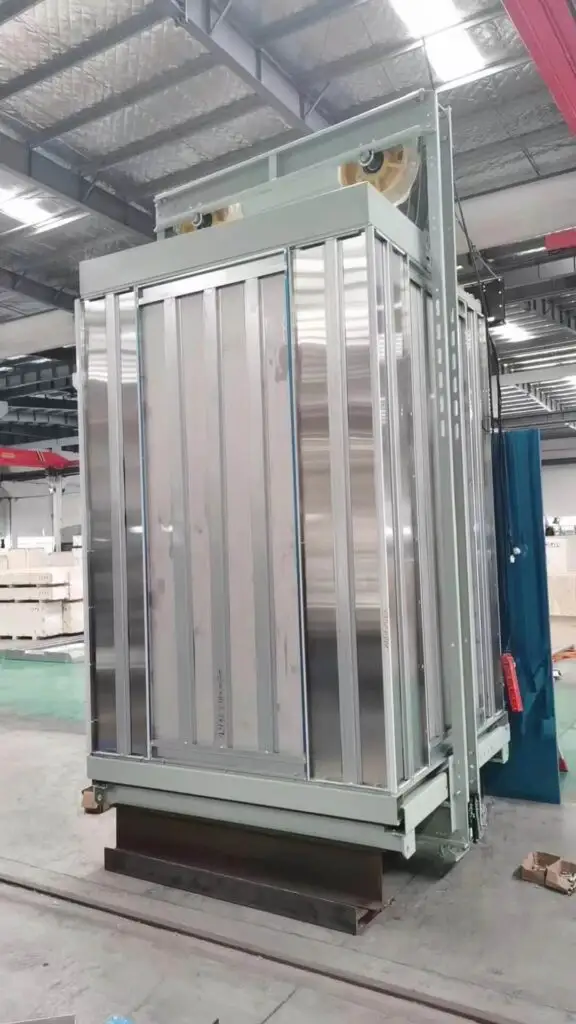Have you ever stopped to consider the vital role that Hospital elevators play in the seamless functioning of healthcare facilities? These unsung heroes silently transport patients, medical staff, and life-saving equipment from one floor to another, ensuring efficient operations and ultimately saving lives.
In fact, did you know that hospital elevators make an astounding 40 billion trips per year in the United States alone? That’s equivalent to approximately 109 million trips per day or 1,270 trips every second!
So learn everything about hospital elevators and their pivotal role in uplifting spirits while ensuring swift and efficient healthcare services.

The Crucial Role of Reliable Hospital Elevators in Saving Lives
According to a study by the American Hospital Association, hospitals in the United States recorded an average of 36.5 million patient admissions annually, highlighting the immense need for reliable and efficient elevator systems in healthcare settings.
Hospital elevators play a crucial role in healthcare facilities, offering numerous benefits and fulfilling essential needs. Firstly, they provide efficient vertical transportation, ensuring quick and smooth movement of patients, medical staff, and equipment throughout the hospital. This reduces delays, enhances patient care, and improves workflow efficiency.
Moreover, hospital elevators are designed to accommodate stretchers and wheelchairs, ensuring safe and comfortable transportation for patients with mobility challenges.

The Features and Benefits of Hospital Elevators
Reliable hospital elevators offer a range of features and benefits that enhance efficiency and safety.
Such elevators optimize patient transportation, streamline workflow, and prioritize safety, ensuring efficient healthcare delivery while safeguarding the well-being of patients and staff.
Smooth and Swift
With smooth acceleration and deceleration, hospital elevators prioritize patient comfort and reduce the risk of discomfort or injury.
By offering a seamless and expedited transportation experience, reliable hospital elevators contribute to the overall efficiency and satisfaction of patients, visitors, and medical staff.
Low Noise
Hospital elevators are designed to operate quietly, minimizing noise levels within the facility. This promotes a peaceful and healing environment for patients, ensuring their comfort and rest.
Low Maintenance
Hospital elevators are built with durable and reliable components, reducing the need for frequent maintenance. This decreases downtime, ensuring uninterrupted service and minimizing disruptions to patient care.
Large Cabin Space
Hospital elevators feature spacious cabins that can accommodate stretchers, wheelchairs, and medical equipment. The ample space allows for comfortable transportation of patients and facilitates the smooth movement of medical personnel.
Multiple Door Opening Methods
Hospital elevators offer various door opening methods such as sliding, folding, or automatic doors. This versatility enables easy access for different situations, including stretcher transportation, wheelchair entry, and efficient flow of personnel in emergencies.
Necessary Attachments Facility
The combination of smart monitoring and emergency communication buttons in hospital elevators provides an added layer of security, detecting any anomalies or malfunctions that may occur.
In the event of an emergency, passengers can quickly and easily access emergency communication buttons to alert staff or summon immediate assistance, ensure patient safety.
Safety
Infection control is a top priority in healthcare facilities, and hospital elevators are designed to facilitate easy and effective infection control measures. These elevators feature materials and surfaces that are resistant to bacteria and easy to clean and disinfect.
Energy Efficiency
Energy efficiency is a key consideration in the design of reliable hospital elevators. These elevators incorporate various features and technologies to minimize energy consumption and reduce environmental impact.
For instance, LED lighting is employed to enhance energy efficiency and reduce power consumption. Intelligent controls optimize elevator operation by adjusting speed, acceleration, and lighting based on passenger traffic, further reducing energy usage.

Hospital Elevator Dimensions
The rated load of the Hospital elevators is 1600KG, and the cabin size must be at least 1400×2400mm to ensure that hospital beds can fit inside. Typically, hospitals choose to have larger cabin sizes in order to provide more space. Here are some common sizes for hospital elevators(W*L*H):
Cabin size: 1400 X 2400 X 2300mm, Shaft size: 2400 X 3000 X 2300mm
Cabin size: 1500 X 2700 X 2300mm, Shaft size: 2400 X 3300 X 2300mm
Cabin size: 1800 X 2700 X 2300mm, Shaft size: 2700 X 3300 X 2300mm
-DAZEN-1024x725.jpg)
How Much Does a Hospital Elevator Cost?
When considering hospital elevator costs, several key factors should be taken into account. Hospital elevator dimensions play a significant role as larger elevators with spacious interiors tend to be more expensive due to the additional materials and engineering required.
Hospital elevator safety is paramount in hospital settings, and elevators designed with advanced safety features may have higher costs. These safety features include emergency communication systems, fire-rated materials, and enhanced door-locking mechanisms.
The cost of a standard hospital elevator can range from $15,000 to $30,000 or more, depending on factors such as capacity, number of floors served, and additional features.
The hospital elevator installation process is another cost factor to consider. As a rough estimate, the installation cost of the hospital elevator is 2000-3000 USD.
Hospital elevator maintenance is essential to ensure the longevity and proper functioning of hospital elevators. Regular maintenance schedules and adherence to safety regulations are crucial, contributing to ongoing costs to ensure the elevators remain in optimal condition.
Overall, when budgeting for hospital elevator costs, it is essential to consider factors such as dimensions, safety features, installation, maintenance, and specific specifications to ensure the elevator meets the facility’s needs while maintaining safety and reliability.

Comparing Hospital Elevators with Regular Elevators
Hospital elevators differ from regular elevators in several key aspects. They prioritize features such as infection control, wheelchair accessibility, advanced destination dispatch systems, and emergency communication buttons. These specialized features cater to the unique needs of healthcare facilities, ensuring efficient and safe transportation for patients, staff, and equipment.
Here’s a comparison table highlighting the differences between hospital elevators and regular elevators:
| Feature | Hospital Elevators | Regular Elevators |
|---|---|---|
| Capacity | Larger weight capacity for equipment, up to 1600-2000kg | Standard weight capacity, about 450-1600kg |
| Dimensions | Spacious, about 280-350 cubic feet to accommodate patients, stretchers, hospital beds, wheelchairs, and medical equipment | Standard dimensions, about 175 cubic feet |
| Speed | 0.4m/s – 3.0m/s for efficient transportation | Generally 1.0m/s – 7.0m/s |
| Configuration | Multiple entrance doors, specialized areas | Single entrance, standard configuration |
| Door opening method | Hands-free, touchless options for infection control along with multiple door opening methods | Manual or automatic door opening with just the middle opening method |
| Interior Features | Handrails, non-slip flooring, ergonomic seating, and a disabled operator box with Braile, adjusted height, and audible controls | Standard interior features; Disabled operator box rarely present |
Hospital Elevator Installation and Maintenance
When it comes to the installation and maintenance of hospital elevators, several crucial considerations should be taken into account. Firstly, hospital elevator dimensions must be carefully evaluated to ensure they meet the specific requirements of transporting patients, medical equipment, and beds.
Sufficient space must be provided to accommodate stretchers and medical personnel.
Compliance with safety codes and regulations, such as proper lighting, emergency alarms, and backup power systems, is essential to ensure the well-being of patients and staff. Regular inspections and testing should be conducted to guarantee the elevator’s safe operation.
During hospital elevator installation, hospital elevator specifications should be meticulously followed, including load capacity, door opening and closing speeds, and accessibility features for individuals with disabilities. Elevators should be designed to minimize vibrations and noise, ensuring a comfortable experience for patients.
Hospital elevator maintenance plays a vital role in keeping hospital elevators in optimal condition. Routine inspections, lubrication of mechanical components, and prompt repairs of any malfunctioning parts are necessary to prevent breakdowns and ensure smooth operation. Regular training and education of maintenance staff are also crucial to stay up to date with the latest safety standards and procedures.

Dazen Hospital Elevator
Dazen Hospital Elevator stands out as a premier choice among other hospital elevators, offering unparalleled features and superior functionality.
With a focus on human-oriented design, Dazen creates a comfortable and heartwarming environment for patients and disabled individuals. The elevators are equipped with stainless steel interiors, ensuring a hygienic and aesthetically pleasing atmosphere. Safety is prioritized through multiple safety designs, reducing the risk of accidents.
Dazen Hospital Elevator’s robust components and systems can effortlessly handle heavy medical equipment, such as stretchers and hospital beds.
Our stable intellectual control system and door system with multiple protection functions guarantee smooth and secure operation.
Choose Dazen Hospital Elevator for exceptional quality, advanced technology, and unwavering commitment to passenger safety!
Hospital Elevator Project
Two hospital elevators completed testing before shipping.
Project Location: Private Hospital in Kosovo
View more

2Set Hospital Elevators Completed Installation in Nigeria
Power failure emergency requirements

